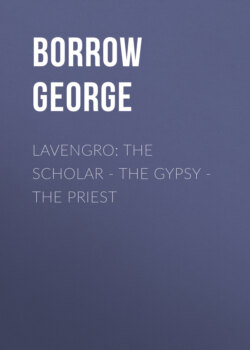Читать книгу Lavengro: the Scholar - the Gypsy - the Priest - Borrow George - Страница 4
На сайте Литреса книга снята с продажи.
II. Is there a Key to “Lavengro”?
ОглавлениеTable of Contents
Dr. Hake, however, and those others among Borrow’s friends who are apt to smile at the way in which critics of the highest intelligence will stand baffled and bewildered before the eccentricities of “Lavengro” and “The Romany Rye”—some critics treating the work as autobiography spoilt, and some as spoilt fiction—forget that while it is easy to open a locked door with a key, to open a locked door without a key is a very different undertaking. On the subject of autobiographies and the autobiographic method, I had several interesting talks with Borrow. I remember an especial one that took place on Wimbledon Common, on a certain autumn morning when I was pointing out to him the spot called Gypsy Ring. He was in a very communicative mood that day, and more amenable to criticism than he generally was. I had been speaking of certain bold coincidences in “Lavengro” and “The Romany Rye”—especially that of Lavengro’s meeting by accident in the neighbourhood of Salisbury Plain the son of the very apple-woman of London Bridge with whom he had made friends, and also of such apparently manufactured situations as that of Lavengro’s coming upon the man whom Wordsworth’s poetry had sent into a deep slumber in a meadow.
“What is an autobiography?” he asked. “Is it a mere record of the incidents of a man’s life? or is it a picture of the man himself—his character, his soul?”
Now this I think a very suggestive question of Borrow’s with regard to himself and his own work. That he sat down to write his own life in “Lavengro” I know. He had no idea then of departing from the strict line of fact. Indeed, his letters to his friend Mr. John Murray would alone be sufficient to establish this in spite of his calling “Lavengro” a dream. In the first volume he did almost confine himself to matters of fact. But as he went on he clearly found that the ordinary tapestry into which Destiny had woven the incidents of his life were not tinged with sufficient depth of colour to satisfy his sense of wonder; for, let it be remembered, that of love as a strong passion he had almost none. Surely no one but Lavengro could have lived in a dingle with a girl like Belle Berners, and passed the time in trying to teach her Armenian. Without strong passion no very deeply coloured life-tapestry can, in these unadventurous days, be woven. The manufactured incidents of which there are so many in “Lavengro” and “The Romany Rye,” are introduced to give colour to a web of life that strong Passion had left untinged. But why? In order to flash upon the personality of Lavengro, and upon Lavengro’s attitude towards the universe unseen as well as seen, a light more searching, as Borrow considered, than any picture of actual experience could have done. In other words, to build up the truth of the character of Lavengro, Borrow does not shrink from manipulating certain incidents and inventing others. And when he wishes to dive very boldly into the “abysmal deeps of personality,” he speaks and moves partly behind the mask of some fictitious character, such as the man who touched for the evil chance, and such as the hypochondriac who taught himself Chinese to ward off despair, but could not tell the time of day by looking at the clock. This is not the place for me to enter more fully into this matter, but I am looking forward to a fitting occasion of showing whether or not “Lavengro” and “The Romany Rye” form a spiritual autobiography; and if they do, whether that autobiography does or does not surpass every other for absolute truth of spiritual representation. Meantime, let it be remembered by those who object to Borrow’s method that, as I have just hinted, at the basis of his character was a deep sense of wonder. Let it be remembered that he was led to study the first of the many languages he taught himself—Irish—because there was, as he said, “something mysterious and uncommon in its use.” Let it be remembered that it was this instinct of wonder, not the impulse of the mere poseur, that impelled him to make certain exaggerated statements about the characters themselves who are introduced into his books.
